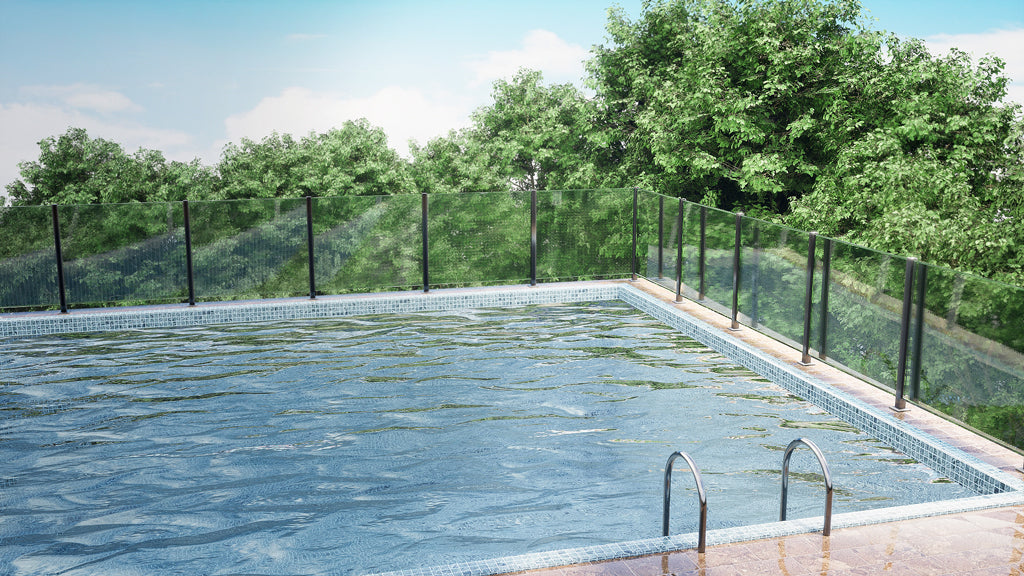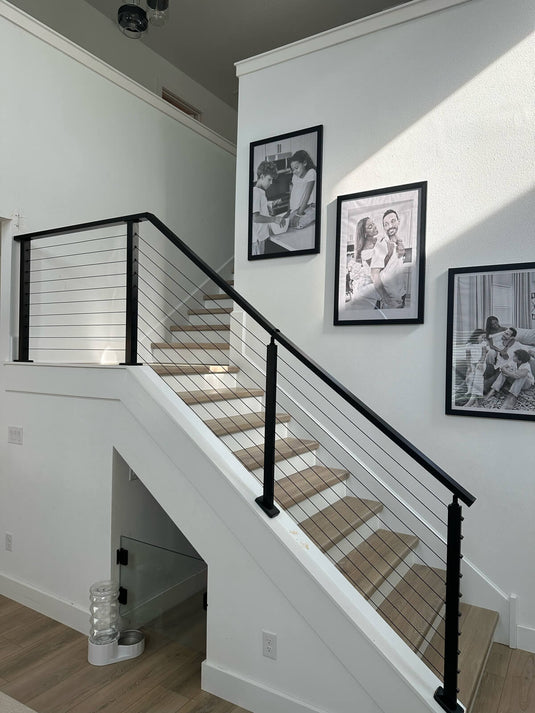TABLE OF CONTENTS
Can You Use Cable Railings for Pool Fencing?
Quick Answer:
Yes, you can use cable railings for pool fencing as long as they adhere to safety standards. Cable railings offer an unobstructed view, durability against the elements, and a sleek, modern appearance. However, to ensure that they serve as effective pool barriers, you must consider several critical factors:
-
Height: They should meet the minimum height requirement (usually at least 4 feet).
-
Spacing: Cables should be spaced no more than 4 inches apart to prevent children from squeezing through.
-
Tension: Cables need to be kept taut to maintain their integrity and prevent gaps from widening.
-
Non-Climbability: Designs should discourage climbing, potentially incorporating angled cables or vertical elements.
-
Maintenance: Regular maintenance is necessary to keep them in optimal condition, including cleaning and tension adjustments.
When designed and installed properly, with attention to detail regarding safety standards, cable railings can be a stylish and secure choice for your pool fencing. Always consult with or hire a professional to ensure compliance with local building codes and safety regulations.
Introduction

If you're looking to keep your pool area safe but still want it to look nice, cable railings might have caught your eye. They're sleek, strong, and don't block your view. But the big question is, can they do a good job of protecting your pool? In this article, we'll talk about whether cable railings are up to the task and how they can be both a safe and stylish choice for your swimming pool fence.
Why Choose Cable Railings for Your Pool Fencing?
Selecting the perfect pool fencing can be a breeze with cable railings. Here’s why they're a smart pick:
- Unobstructed Views: Cable railings are almost invisible, offering clear sightlines. This means you can easily keep tabs on the pool area, enhancing safety without sacrificing style.
- Toughness: Made from stainless steel, cable railings resist corrosion and stand strong against weather and chlorine—essential qualities for poolside durability.
- Safety Compliance: Their strength meets safety standards, making them reliable barriers that don’t buckle under pressure.
- Flexible Design: These railings fit any home style, with customizable options that align with your existing decor.
- Open Feel: They create an airy environment, helping small spaces feel larger and more inviting.
- Low Upkeep: Forget frequent maintenance; a simple occasional clean is all that’s needed to keep them pristine.
- Added Value: Cable railings are a long-lasting investment that can elevate property value with their upscale look.
What Should You Know About Cable Railings for Pools?
Before deciding if cable railings are right for your pool, it's important to understand what they are and what makes them a popular choice for some homeowners.
What Are Cable Railings?

Cable railings are modern, minimalist barriers made up of horizontal or vertical cables stretched between posts. These posts can be made of various materials like stainless steel, aluminum, or wood. The cables themselves are usually made of stainless steel due to its strength and resistance to rust, which is especially important in the damp environment around a pool.
Why Choose Cable Railings?
One of the biggest draws of cable railings is their sleek appearance, which offers an uncluttered view of your surroundings — perfect for showcasing your pool area. They're also known for their durability; stainless steel cables can handle a lot of wear and tear and resist weather damage. Plus, they require relatively low maintenance, only needing occasional cleaning and tightening to keep them looking good and functioning well.
Challenges with Cable Railings in Pool Safety
While cable railings are strong and have a modern look, there are specific challenges when using them as pool fencing. The main concern is that the horizontal layout of the cables could potentially provide footholds for children to climb, which is something you want to avoid with pool fencing. Also, because the cables are under tension, if not installed correctly or if they become loose, the gaps between them might widen, which could be a safety risk.
How to Evaluate Cable Railings for Pool Fences
To determine if cable railings are a good fit for your pool area, we need to address how they match up with safety standards specifically designed for pool fencing.
Meeting Height Requirements
The height of a pool fence is one of the first lines of defense against accidental entry into the pool area. Cable railings can easily meet the minimum height requirement, which is typically four feet. Customization options allow for even taller constructions if desired, providing flexibility to those seeking extra security.
Ensuring Small Gap Spacing
For traditional pool fences, making sure that vertical bars are close enough together to prevent children from slipping through is paramount. With cable railings, the concern shifts to the horizontal spacing of cables. To maintain a safe environment, it's crucial that cable railings have tight spacing between the cables, no more than four inches apart, to prevent kids from squeezing through or getting stuck.
Maintaining Cable Tension
The tension of cable railings is vital to pool safety. Cables must be taut enough to withstand pressure and not stretch out over time, which could lead to increased gaps or even structural failure. High-quality materials and professional installation are essential to ensure that the tension remains consistent and secure, especially in the dynamic environment of a pool area.
Structural Integrity and Non-Climbability
Besides maintaining proper tension and spacing, cable railings need to resist being used as a ladder. This means designing the railing system in a way that minimizes horizontal elements that could facilitate climbing. One strategy is to install the cables at an angle or mix in vertical elements, which can help deter children from attempting to climb the fence.
By taking these considerations into account, homeowners can get a clearer picture of whether cable railings are a responsible choice for their pool fencing needs.
How to Enhance Pool Safety with Cable Railings

If you're leaning towards the sleek look of cable railings for your pool fence, it's important to know how to adapt them for optimal safety. Here are some practical ways to enhance the safety features of cable railings around a pool.
Adapting Cable Design to Discourage Climbing
Horizontal cables can inadvertently act like a ladder for curious kids. To counter this, consider installing the cables at an angle or incorporating vertical cable patterns that are harder to climb. Another way to deter climbing is by choosing a railing design that includes a combination of materials, such as glass panels or solid inserts at the lower levels where climbing is most likely.
Keeping Cables Tight and Secure
Over time, cable tension can loosen, which could create unsafe gaps. It's essential to choose high-quality cable and end-fittings capable of maintaining their tension. Also, regular inspection and adjustment (if necessary) are key to ensuring the integrity of the barrier. Some railing systems come with built-in turnbuckles or other tightening mechanisms that make it easier to keep cables properly tensioned.
Adding Pool Gates That Match Safety Standards
A fenced area needs at least one entry point, and when it comes to pools, that gate must be just as secure as the fence itself. Gates in cable railing systems should have self-closing and self-latching mechanisms placed high enough to be out of reach of small children. Ensure that the gate structure supports the same spacing and tension requirements as the rest of the railing system.
Accessorizing for Increased Safety
Beyond the structure of the fence itself, pool safety can be further enhanced with accessories like pool alarms, which sound when someone enters the pool area, and pool covers that provide an additional layer of protection when the pool is not in use.
What's the Lifespan of Cable Railings When Used as Pool Fencing?
The lifespan of cable railings as pool fencing can vary based on several factors, including material quality, environmental conditions, and maintenance practices. Generally speaking, when made from high-grade materials and maintained properly, cable railings can last for decades.
Stainless steel cable railings can often endure for upwards of 20 years or more when installed correctly and cared for. Their longevity comes down to the inherent durability of the material, which doesn't succumb easily to environmental stresses or everyday wear and tear.
To maximize the lifespan of your cable railings:
- Choose the right grade of stainless steel.
- Apply a protective coating if recommended by the manufacturer.
- Conduct regular cleaning to remove any chemical residues or environmental deposits.
- Inspect the tension and condition of the cables periodically to ensure they remain secure and intact.
Final Thoughts
Cable railings can be both stylish and secure for your pool area if you get the details right. They need to stand tall, have cables that are close together, and be strong enough to stay put under pressure. Remember to check on them from time to time and keep them well-maintained. If you're thinking about going with cable railings, it's smart to talk to a professional who can help make sure your fence checks all the safety boxes. With their help, you'll be set to enjoy a clear view of your poolside paradise while keeping safety in the forefront.




